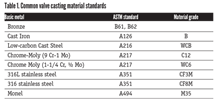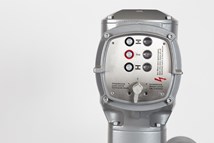HVOF Coatings for Severe Service Valves
Chrome carbide is one coating that can be done during manufacturing or repairs that extends service life of valves and other flow control components.
#maintenance-repair #components #ball-butterfly-plug
Valves are a vital component in oil and gas, water treatment, mining and chemical processing, regulating the flow of fluids with high precision and reliability.
Severe service valves are used in the most difficult environments within a process. These severe service environments include erosive, corrosive, high-pressure, high-temperature, and high-velocity media or slurry media.
Over time, valves experience wear leading to costly repairs or replacements. For valves facing severe service conditions, thermal spray coatings like high-velocity oxygen fuel (HVOF) applied coatings, specifically chrome carbide, offer a solution that significantly enhances the performance and longevity of critical components.
HVOF coatings: high performance for severe conditions
HVOF is a thermal spray process that involves spraying molten or heated material onto a surface at high velocity, creating a dense and durable coating. Developed in 1980, HVOF-applied chromium carbide has significantly advanced in the subsequent years, making it a good solution for valves and other components to extend the life of equipment by increasing wear and erosion resistance.

Ball valve component undergoing robotically applied HVOF spray process.
Source: Precision Spray & Coatings
The primary advantage of HVOF chrome carbide coatings is their mechanical bond, which offers superior adhesion compared to other spray processes. Unlike welded overlays, which create a metallurgical bond, HVOF coatings achieve a strong mechanical bond without altering the underlying material’s structure. This helps preserve the integrity of the valve while enhancing its performance.
Chrome carbide is particularly effective due to its exceptional hardness, wear resistance and ability to withstand high-temperature environments. Carbides are primarily used to create a hard surface to resist fretting, wear and erosion and to provide low coefficients of friction. Chrome carbides have an additional function of heat resistance and are generally prescribed for high-temperature applications.

HVOF carbide coating balls for ball valves.
Source: Precision Spray & Coatings
These coatings are commonly applied to valves to enhance their wear resistance, hardness and durability. They provide excellent protection against harsh operating conditions. The dense, tough chrome carbide layer significantly improves the valve’s lifespan by reducing friction and preventing material degradation, making it an ideal choice for critical components exposed to extreme environments. This coating ensures the valves maintain optimal performance and reliability over time.
These characteristics make chrome carbide an ideal coating for valves, such as ball valves, that are subjected to erosive and corrosive conditions.
The need for valve repair and coating
Many operators choose to repair valves rather than replace them during shutdowns and planned maintenance. During the planned period, experienced vendors can be contracted to complete the repairs within a few weeks.

Inspection of chrome carbide-coated and lapped ball and seats.
Source: Precision Spray & Coatings
Valve repairs are a complex process involving the evaluation of components such as the stem, body and seats on all valves, and components such as the ball in ball valves. Soft goods like packing, gaskets and seals must be replaced, while metal parts can often be repaired through welding or coating to restore functionality. Repairing a valve instead of replacing it can save time and money for operators, especially because downtime is costly. The faster a turnaround happens, the faster the plant is returned to service. HVOF coatings can be an essential part of this repair process, restoring damaged surfaces and enhancing valve components’ resistance to wear and corrosion.
A cost-effective solution
When operators choose to finish valves with the addition of HVOF chrome carbide coatings, a valve’s lifespan is extended, minimizing the frequency of repairs and reducing long-term operational costs. The ability to modify and improve the valve during the repair process also provides an opportunity for performance optimization, making this solution even more attractive for industries that require high reliability. If you are an operator, working with a trusted valve repair service provider can save you not only money but time during crucial shutdowns, and can help prevent unscheduled maintenance and repairs in the future.

Kelly Songer is a third-generation industrial manufacturer with more than 20 years experience. In 2016, she was featured as a “Legacy Leader” by the National Association of Manufacturers and in 2017 she was honored with the Service Award from the Valve Manufacturers Association.
RELATED CONTENT
-
The Valve Industry Finds Value in ESG Initiatives
The valve manufacturing industry in North America is one of the industries that have embraced this new way of thinking and is leading the way with the integration of environmental, social, and governance (ESG) initiatives. These initiatives range from valves designed to mitigate climate change to community involvement activities.
-
In the Air: Wireless Trends in Smart Pneumatics
In today’s wireless world it’s no surprise that automation and manufacturing spaces have embraced—and sought out—the connectivity and convenience that wireless technologies offer.
-
Gaskets Are Not Created Equal
Gaskets are near the bottom of the food chain of valve components; trim, body materials and packing seem to get a lot more press.











 Unloading large gate valve.jpg;maxWidth=214)